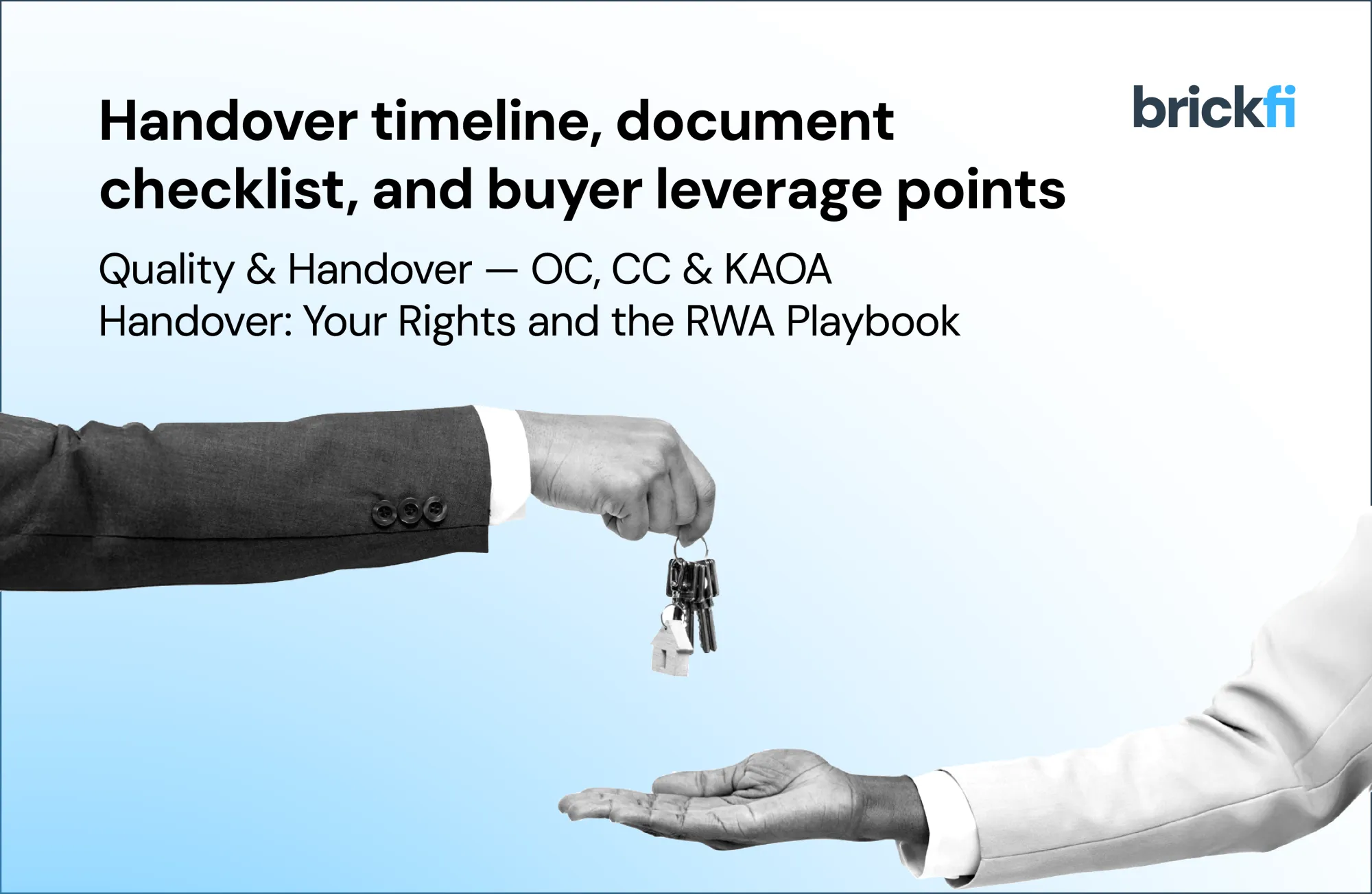OC, CC & KAOA Handover: Your Rights and the RWA Playbook
Confused about apartment handover in Bangalore? Learn about Occupancy Certificate (OC), Completion Certificate (CC), KAOA society formation, and RWA handover checklist with buyer leverage points.

Key Takeaways
- Handover is more than just keys: It includes legal certificates, amenities, and financial transparency.
- Occupancy Certificate (OC) and Completion Certificate (CC) are must-haves for any apartment handover in Bangalore. Without them, your flat may be deemed “unauthorized.”
- Under the Karnataka Apartment Ownership Act (KAOA), society formation is mandatory for long-term management of common areas.
- Handover timeline: Typically 3–6 months post-OC, but delays are common; RERA gives buyers leverage to demand accountability.
- Buyers should use a handover document checklist covering CC, OC, approved plans, NOCs, and financial audits before taking possession.
- The RWA (Resident Welfare Association) handover checklist includes everything from as-built drawings to corpus fund transfers, which buyers can demand under KAOA.
Why Handover Matters More Than You Think
Buying an apartment in Bangalore doesn’t end with registration. The real test begins at handover. This is when the builder is supposed to:
- Deliver your flat with the promised specifications
- Provide legal clearances like Occupancy Certificate (OC) and Completion Certificate (CC)
- Transfer management to the owners’ association under KAOA (Karnataka Apartment Ownership Act)
But in practice, handovers are often murky. Builders delay issuing certificates, associations form late, and financial transparency gets lost. That’s why every buyer needs to understand handover rights, timelines, and leverage points.
Get instant access to expert, data-driven property insights.
Request your free Brickfi investment report now and make smarter real estate decisions today.
Step 1: Understanding OC & CC
Occupancy Certificate (OC)
- Definition: Issued by BBMP/BDA after verifying that the building is fit for occupancy and built as per the sanctioned plan.
- Why it matters: Without an OC, your flat may be considered “illegal construction,” meaning no Khata transfer, no water/electricity connection, and no resale approval.
- Typical Delay: Builders hand over without OC to avoid waiting, but this leaves buyers vulnerable.
Completion Certificate (CC)
- Definition: Certifies that construction is complete as per the sanctioned plan and building bye-laws.
- Scope: Includes verification of height, setbacks, fire safety, and environmental compliance.
- Buyer Tip: Always demand the CC before possession; it’s proof the builder hasn’t deviated.
For any apartment handover in Bangalore, both the occupancy certificate Bangalore and the completion certificate apartment are non-negotiable documents.
Step 2: The Handover Timeline
While RERA has streamlined timelines, here’s what typically happens:
First, construction is completed, and the builder applies for the Completion Certificate.Once the Completion Certificate is issued, the builder applies for the Occupancy Certificate.When the Occupancy Certificate is issued by BBMP or BDA, the builder begins offering possession.Next, the process of KAOA society formation is initiated and owners sign declarations.Finally, the RWA handover checklist is executed and the builder transfers assets and documents.
Ideal Timeline: 3–6 months from completion to handoverReality: Often stretched to 12+ months due to pending clearances
Buyer Leverage: If the handover exceeds promised deadline, RERA empowers buyers to seek:
- Interest compensation
- Refund with penalty
- Filing a complaint for project delay
Get instant access to expert, data-driven property insights.
Request your free Brickfi investment report now and make smarter real estate decisions today.
Step 3: The Handover Document Checklist
Before taking possession, insist on these documents:
- Occupancy Certificate (OC)
- Completion Certificate (CC)
- Approved Building Plan & Sanction Letters
- Fire NOC & Environmental Clearances
- As-Built Drawings (Electrical, Plumbing, Layout)
- Warranty Certificates (Lifts, Generators, STP, etc.)
- Corpus Fund Statement (builder must transfer collected fund)
- Audit Reports of Maintenance Charges
- Insurance Policy of Building (if applicable)
- Sale Deed with Parking Rights & Amenities details
Pro Tip: Create a digital folder, most buyers lose track of half these documents once moved in.
Step 4: KAOA Society Formation and Why It’s Non-Negotiable
Under KAOA, every apartment project must form an Owners’ Association to:
- Legally own common areas
- Manage finances and maintenance
- Enforce by-laws and parking rules
- Handle disputes with the builder or municipal bodies
Steps in KAOA Society Formation:
- Declaration Filing: Builder submits a declaration to Registrar of Cooperative Societies.
- Deed of Apartment: Each flat registered with details of undivided share (UDS).
- By-laws Drafting: Defines rules for management, voting rights, and maintenance.
- First General Body Meeting: Elects Resident Welfare Association (RWA).
- Handover: Builder transfers all assets and liabilities to the RWA.
Without society formation, residents are at the mercy of the builder’s maintenance agency.
Get instant access to expert, data-driven property insights.
Request your free Brickfi investment report now and make smarter real estate decisions today.
Step 5: The RWA Handover Checklist
When the builder hands over to the Resident Welfare Association, here’s what buyers should demand:
- As-built Drawings: Electrical, plumbing, fire safety, STP layouts
- Legal Documents: OC, CC, sanction plans, NOCs
- Asset Handover: Lifts, generators, pumps, fire-fighting equipment with warranty papers
- Financial Handover: Corpus fund, sinking fund, and unspent maintenance advance
- Service Contracts: AMC agreements for lifts, DG, STP, etc.
- Utility Connections: Water, electricity, sewage connections transferred in society’s name
- Pending Litigation Status: Any cases filed against the project disclosed
Buyer Leverage Point: RERA allows buyers to file complaints if the builder fails to execute a proper handover. Associations can even seek legal action under KAOA.
Practical Leverage Points for Buyers
- No OC? No Possession: Politely but firmly refuse possession until OC is shared.
- Check for Deviations: Compare approved plan vs. as-built, any violations can hurt resale value.
- Use RERA: File for delayed handover or missing documents, fast-track hearings are common.
- Demand Corpus Transparency: Ensure builder-transferred fund matches what was collected.
- Involve Multiple Buyers: A group complaint or representation to BBMP is far stronger than individual requests.
Final Word
A flat without proper handover is like owning half a house. OC, CC, and KAOA society formation are not paperwork formalities; they safeguard your ownership, resale, and daily living.
For Bangalore’s homebuyers, this is the real “possession milestone.” A well-executed handover ensures:
- You live in a legally recognized home
- You own a share of all common amenities
- You control your maintenance costs transparently
At BrickFi, we help buyers go beyond the keys to demand every right in the handover timeline, document checklist, and RWA playbook.
FAQs
What is the difference between OC and CC?
- CC certifies completion of construction.
- OC certifies fitness for occupation after inspection.
Can I move in without an OC?
Technically no. Without an OC, your home is not legally habitable. Banks may refuse loans, and the BBMP may cut utilities.
What is KAOA, and why is it important?
The Karnataka Apartment Ownership Act ensures residents collectively own and manage common areas. Without KAOA registration, associations lack legal standing.
What if the builder refuses to form an association?
Buyers can form one themselves under KAOA or Karnataka Societies Registration Act and approach RERA for enforcement.
What documents must a builder hand over to the RWA?
OC, CC, as-built drawings, insurance, financial statements, service contracts, and corpus fund.
Get instant access to expert, data-driven property insights.
Request your free Brickfi investment report now and make smarter real estate decisions today.
